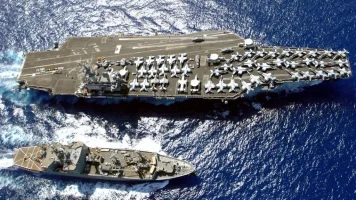- Views: 4K
- Replies: 26

The Indian Navy's ambitious project to develop a next-generation, carrier-borne fighter jet, the Twin Engine Deck-Based Fighter (TEDBF), is making significant progress.
An official from the Aeronautical Development Agency (ADA) confirmed that the program is on schedule to achieve its Critical Design Review (CDR) by 2026. This information was shared during the Aero India 2025 exhibition, which took place from February 10-14 at Yelahanka Air Force Station.
The TEDBF is envisioned as an advanced, "fifth-generation minus" fighter, incorporating many cutting-edge technologies, though it will not possess full fifth-generation stealth characteristics. It's designed to operate from the Indian Navy's aircraft carriers, ultimately replacing the current fleet of MiG-29K fighters. The TEDBF will also serve alongside the naval variant of the Light Combat Aircraft (LCA Navy). The aircraft's twin-engine design will provide increased range, payload, and operational adaptability, which are crucial for India's maritime security.
The development is being spearheaded by the ADA in collaboration with the DRDO and various industry partners. The goal is to produce a carrier-capable fighter jet uniquely suited to the Indian Navy's operational needs. The allocated budget of approximately ₹14,000 crore (roughly $1.68 Billion USD, as of current exchange rates) will support the creation of five prototypes and the incorporation of essential technologies.
The CDR, a crucial stage in the development process, involves a thorough evaluation of the aircraft's design. The ADA expects to complete and submit this comprehensive review to the Indian Navy by 2026. The CDR will rigorously examine the jet's technical viability, performance capabilities, and adherence to the Navy's specific requirements. If the Indian Navy approves the CDR, the TEDBF program will then be presented to the Cabinet Committee on Security (CCS) for final approval. The ADA official expressed optimism that this approval could be secured by 2027, initiating full-scale development and the construction of prototypes.
The ADA has projected a 2038 target date for the TEDBF's entry into service with the Indian Navy, contingent upon the program proceeding according to the current plan. This timeline encompasses the construction, rigorous testing, and certification of the five planned prototypes.
The Indian Navy has specified 14 key features for the TEDBF, reflecting its demands for carrier-based operations. The ADA is committed to integrating these features to ensure the aircraft meets the Navy’s exacting specifications. Among these crucial capabilities are:
- Automated Takeoff and Landing: The TEDBF will incorporate sophisticated systems for automated takeoff and landing on aircraft carriers. This will reduce the pilot's workload and improve safety during operations in demanding sea conditions.
- Wing-Folding Mechanism: To maximize storage efficiency on aircraft carriers such as INS Vikrant and INS Vikramaditya, the TEDBF will include a wing-folding mechanism, enabling compact storage within the ships' limited hangar space.
- Twin-Engine Configuration: Utilizing two General Electric F414 engines, the TEDBF is designed for greater thrust, reliability, and resilience, particularly when compared to single-engine aircraft. This configuration is essential for extended missions over the Indian Ocean. (The GE F414 is a widely used afterburning turbofan engine known for its reliability and performance in aircraft like the F/A-18E/F Super Hornet).
- Advanced Avionics and Sensors: The jet will be equipped with state-of-the-art avionics, including an Active Electronically Scanned Array (AESA) radar, electronic warfare capabilities, and a modern cockpit interface. These systems will significantly enhance situational awareness and overall combat effectiveness.
- Multi-Role Capability: The TEDBF is conceived as a versatile, multi-role fighter. It will be capable of performing air superiority, ground attack, and maritime strike missions, providing flexibility across a wide spectrum of operational needs.

